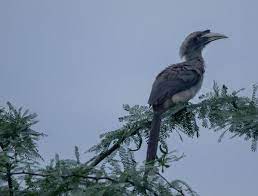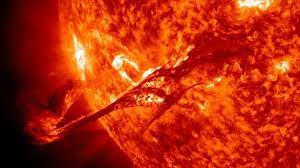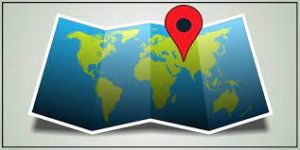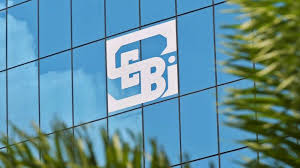Today’s Current Affairs: 10th Jul 2023 for UPSC IAS exams, State PSC exams, SSC CGL, State SSC, RRB, Railways, Banking Exam & IBPS, etc
Table of Contents
Indian Grey Hornbill : Sighted

The Indian grey hornbill (Ocyceros birostris) was sighted by a bird enthusiast from the Nature and Wildlife Forums in Koodapakkam, near the Sankarabarani river in Puducherry.
- Indian Grey hornbill is a common hornbill found on the Indian subcontinent.
- It is commonly sighted in pairs.
- These birds are known to be arboreal,e., spend most of their time on tall trees, but may descend for food and to collect mud pellets for nesting.
- It has grey feathers all over the body with a light grey or dull white belly.
- The horn is black or dark grey with a casque extending to the point of curvature of the horn.
- Unlike a lot of other birds, the male and female look similar
- It is one of the few hornbill species found in urban areas in many cities where they are able to make use of large trees in avenues.
- They play an essential role in the ecosystem as prime dispersers of seeds.
- Indian subcontinent; found from north-east Pakistan and south Nepal east to north-west Bangladesh and south throughout most of India except in Assam.
- Conservation status
- IUCN: Least Concern
Solar Flares : Disrupted Radio Communications Over Parts Of The United States

The Sun emitted an X-class solar flares which disrupted radio communications over parts of the United States and the Pacific Ocean.
- Solar flares are magnetic plasma ejected at great speed from the solar surface.
- They occur during the release of magnetic energy associated with sunspots (‘dark’ regions on the Sun that are cooler than the surrounding photosphere), and can last for a few minutes or hours.
- These flares can be divided into various categories based on their brightness in X-ray wavelengths
- There are five different classes of solar flares: A, B, C, M, and X.
- Each class is at least ten times more potent than the one before it.
- X-class flares are large and M-class are medium-sized flares typically result in brief radio blackouts that affect the Earth’s Polar Regions.
- C-class flares are slight and have little effect on the Earth.
Geocoding : Functionality Live For All States And Union Territories

The Goods and Services Tax Network (GSTN) made the geocoding functionality live for all states and union territories.
- There are concerns over fake registrations and fraudulent availment of input tax credit under the Goods and Services Tax (GST) regime.
- Geocoding converts an address or description of a location into geographic coordinates.
- It has been introduced to ensure the accuracy of address details in GSTN records and streamline the address location and verification process.
- GST Network has already geocoded 1.8 crore principal places of businesses.
- The functionality is available for normal, composition, SEZ units, SEZ developers, input service distributor and casual taxpayers who are active, cancelled, and suspended.
- This is a one-time activity and once submitted, revision in the address is not allowed.
- The functionality will not be visible to the taxpayers who have already geocoded their address through new registration or core amendment.
SEBI Complaints Redress System (SCORES) Platform:

A total of 3,079 complaints against companies and market intermediaries have been disposed of through the Securities and Exchange Board of India’s (SEBI) SCORES platform recently.
- SCORES Platform is a web based centralized grievance redress system of SEBI that was launched in June 2011.
- SCORES enables investors to lodge and follow up their complaints and track the status of redressal of such complaints online from the above website from anywhere.
- This enables the market intermediaries and listed companies to receive the complaints online from investors, redress such complaints and report redressal online.
- All the activities starting from lodging of a complaint till its closure by SEBI would be online in an automated environment and the complainant can view the status of his complaint online.
- According to the regulatory authority, complaints can be lodged on SCORES for any issues covered under the Sebi Act, Securities Contract Regulation Act, Depositories Act, and rules and regulations and provisions of Companies Act, 2013.
SEBI:
- It was established in April 1988 as an executive body and was given statutory powers in January 1992 through the SEBI Act, 1992.
- It monitors and regulates the Indian capital and securities market while ensuring to protect the interests of the investors, formulating regulations and guidelines.
Notification To Bring The GSTN Under The Purview Of The PMLA:

The Central Government recently issued a notification to bring the Goods & Services Tax Network (GSTN) under the purview of the Prevention of Money Laundering Act (PMLA).
- Prevention of Money Laundering Act (PMLA) is an Act to prevent money laundering and to provide for the confiscation of property derived from or involved in money laundering.
- The Act was formulated for the following objectives:
- Prevent money-laundering.
- Combat/prevent channelising of money into illegal activities and economic crimes.
- Provide for the confiscation of property derived from, or involved/used in, money laundering.
- Provide for matters connected and incidental to the acts of money laundering.
- The Enforcement Directorate (ED) in the Department of Revenue, Ministry of Finance, is responsible for investigating the offences of money laundering under the PMLA.
- Financial Intelligence Unit – India (FIU-IND), under the Department of Revenue is the central national agency responsible for receiving, processing, analysing, and disseminating information relating to suspect financial transactions.
- The scheduled offences are separately investigated by agencies mentioned under respective acts, for example, the local police, CBI, customs departments, SEBI, or any other investigative agency, as the case may be.
- Actions that can be initiated against the person involved in money laundering:
- Seizure/freezing of property and records and attachment of property obtained with the proceeds of crime.
- Any person who commits the offence of money laundering shall be punishable with –
- Rigorous imprisonment for a minimum term of three years and this may extend up to seven years.
- Fine (without any limit).
Enteroviruses : Rising Incidence

The World Health Organization (WHO) has warned against the rising incidence of enterovirus infections in a few countries across Europe.
- Enterovirruse are a group of viruses that can cause various infectious illnesses and are responsible for annual epidemics.
- There are many kinds of enteroviruses, including coxsackieviruses, echoviruses, polioviruses, and the hepatitis A virus.
- All enteroviruses are antigenically heterogeneous and have wide geographic distribution.
- They can infect anyone, but are more likely to cause illnesses in people with weak immune systems, as well as infants, children, and teens who don’t have immunity against a virus yet because it’s their first exposure to it.
- Illness is usually mild but has been found to affect neonates differently and sometimes more severely than older children and adults.
- There are multiple transmission routes, particularly in the neonatal period, including intrapartum by exposure to maternal blood, secretions, and/or stool, or postnatally from close contacts with infected caregivers.
- Symptoms:
- Most people with an enterovirus infection don’t get sick.
- For those who do, symptoms depend on the type of enterovirus and which part of the body it affects.
- Most often a child will simply have a fever or mild cold symptoms such as runny nose, sneezing, coughing, or muscle aches.
Global Survey On Digital And Sustainable Trade Facilitation:

The United Nations Economic and Social Commission for Asia Pacific (UNESCAP) released Global Survey on Digital and Sustainable Trade Facilitation.
- It is conducted every two years by UNESCAP.
- The 2023 survey covered more than 140 economies and evaluated 60 trade facilitation measures
Key findings:
- It has recognized India’s exceptional progress across various sub indicators, with the country achieving a perfect score of 100% in four key areas: Transparency, Formalities, Institutional Arrangement and Cooperation, and Paperless Trade.
- India has witnessed a substantial improvement in the score for “Women in Trade Facilitation” component from 66.7% in 2021 to 77.8% in 2023.
- India is now the best performing country amongst all the countries of South Asia region.
- The overall score of India has been greater than many developed countries including Canada, France, UK, Germany etc.
UNESCAP:
- It is the most inclusive intergovernmental platform in the Asia-Pacific region which was established in 1947.
- Member countries: It consists of 53 members and 9 associate members.
- India is also a member of this organization.
- Headquarters:Bangkok, Thailand
- It works to overcome some of the region’s greatest challenges by providing results-oriented projects, technical assistance, and capacity building to member States
Performance Grading Index (PGI) : For Year 2021-2022

The Union Ministry of Education released report on Performance Grading Index 2.0 for States/UTs for the year 2021-22.
Performance Grading Index:
- It was first released for the year 2017-18 and so far it has been released up to the year 2020-21.
- It assesses the performance of school education system at the State/UT level by creating an index for comprehensive analysis.
- Aim of PGI 2.0: To propel States & UTs towards undertaking multi-pronged interventions that will bring about the much-desired optimal education outcomes covering all dimensions.
- The PGI 2.0 structure comprises of 1000 points across 73 indicators grouped into 2 categories viz., Outcomes, Governance Management (GM).
- These categories are further divided into 6 domains,, Learning Outcomes (LO), Access (A), Infrastructure & Facilities (IF), Equity (E), Governance Process (GP) & Teachers Education and Training (TE&T).
- PGI 2.0 for 2021-22 classified the States/UTs into ten grades viz., highest achievable Grade is Daksh, which is for State/UT scoring more than 940 points out of total of 1000 points.
- The lowest grade is Akanshi-3 which is for score up to 460.
- Indicators of PGI 2.0 have been aligned to policy initiatives and interventions introduced post implementation of National Education policy (NEP) 2020 for proper tracking the progress.
- The PGI 2.0 is expected to help States and UTs to pinpoint the gaps and accordingly prioritize areas for intervention to ensure that the school education system is robust at every level.
Whole-Genome Sequencing : In Newborns

The use of rapid whole-genome sequencing (WGS) in newborns, including healthy newborns, has emerged as a revolutionary approach to diagnose and treat genetic diseases.
- By providing a comprehensive view of an infant’s genetic makeup, this technology enables healthcare workers to make fast and effective diagnoses, leading to improved outcomes and reduced healthcare costs
- Whole-Genome Sequencing all organisms have a unique genetic code, or genome, that is composed of nucleotide bases- Adenine (A), Thymine (T), Cytosine (C) and Guanine (G).
- The unique Deoxyribonucleic Acid (DNA) fingerprint, or pattern can be identified by knowing the sequence of the bases in an organism.
- Determining the order of bases is called sequencing.
- Whole genome sequencing is a laboratory procedure that determines the order of bases in the genome of an organism in one process.
- Importance of Sequencing Newborn Genomes:
- Rapid, precise diagnosis of rare genetic diseases not detected by standard screenings.
- Detection of treatable conditions, enabling early intervention or gene-based therapies.
- Insight into future health risks, facilitating informed choices and preventive measures.
- Revelation of ancestry, traits, and carrier status for personal and social value.
U.S. Destroys Last Of Its Declared Chemical Weapons:

The United States has destroyed the last of its declared chemical weapons stockpile, a milestone in the history of warfare dating back to the First World War.
- The U.S. faced a September 30 deadline to eliminate its remaining chemical weapons under the international Chemical Weapons Convention.
- Chemical Weapons Convention is a multilateral treaty that bans chemical weapons and requires their destruction within a specified period of time.
- It entered into force on April 29, 1997.
- It requires states-parties to declare in writing to the OPCW their chemical weapons stockpiles, chemical weapons production facilities (CWPFs), relevant chemical industry facilities, and other weapons-related information.
- The CWC is open to all nations and currently has 193 states-parties.
- India is a signatory and party to the Chemical Weapons Convention.
- It has signed the treaty at Paris on 14th day of January 1993.
- It is pursuant to provisions of the Convention enacted the Chemical Weapons Convention Act, 2000.
Organisation for the Prohibition of Chemical Weapons (OPCW):
- It is the implementing body of the Chemical Weapons Convention (CWC).
- Mission: To implement the provisions of the Chemical Weapons Convention (CWC) in order to achieve the OPCW’s vision of a world that is free of chemical weapons and of the threat of their use, and in which cooperation in chemistry for peaceful purposes for all is fostered.
- Headquarters: Hague, Netherlands.
- It receives states-parties’ declarations detailing chemical weapons-related activities or materials and relevant industrial activities.




